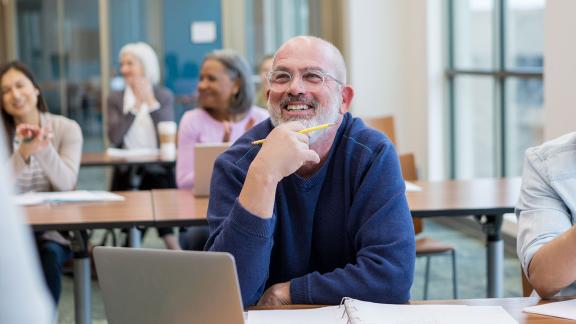
Introduction
Clinical placements are a cornerstone of healthcare education and workforce development. As the 10-Year Health Plan sets out a transformative vision of shifting care from hospitals to communities, from analogue to digital systems, and from reactive treatment to proactive prevention, placements play a critical role in preparing the future workforce to deliver on these ambitions.
Employers have highlighted the challenge of balancing placement capacity with the need to provide high-quality, inclusive experiences for a diverse range of learners. This includes individuals undertaking work experience, T Levels, BTECs, pre and post-registration programmes, and both traditional and apprenticeship routes. Ensuring robust placement opportunities is essential to equipping students with the skills and adaptability required to meet the evolving demands of modern healthcare.
This guide aims to provide employers with practical examples to help manage and diversify their placement capacity whilst providing an excellent student learning experiences. Evidence shows that students who have a good placement experience will normally apply for a position within that organisation/specialty at the end of their training.
The key challenges
Historically, the ability to take on learners for whom practice-based learning is a requirement of their programme has been limited by challenges outlined below.
Identifying your capacity for students
Using placement management systems
The Fair Share Model
The Fair Share Model for allied health professionals was developed in partnership with NHS England (previously Health Education England) to help benchmark the provision of practice learning relative to workforce capacity. The guidance is based on trusts located in the London region and focuses on physiotherapy (PT), occupational therapy (OT) and speech and language therapy (SLT). However, other NHS trusts can use this for capacity planning and to support the future AHP workforce (and potentially other disciplines) through placement provision per full time equivalent.
The Fair Share Model in practice at The Royal Marsden Hospital
The Royal Marsden Hospital applied the Fair Share Model to anticipate its capacity for PT, OT and SLT students a year ahead of intake. The algorithms reflected their actual capacity more accurately, and it was able to increase its OT and PT/SLT student placement capacity by 67 and 90 per cent respectively since 2022.
As part of a quality improvement project, the therapies education team launched a staff survey to explore what helps or hinders clinicians in taking students. Key barriers included staffing levels, productivity demands, space constraints, and communication with universities. In response, the team implemented strategies to address these issues, including:
Managing and coordinating capacity
Centralising the decisions for placing students can be helpful for NHS organisations in system settings. It can make it easier to coordinate effectively with HEIs, FE and schools and help future planning of student placements. The below example demonstrates how a new role was adapted to enable effective system working and coordinate student capacity.
University Hospitals Sussex
University Hospitals Sussex (UHS) faced coordination challenges with managing student placements across ten HEIs. Universities directly assigned nursing, midwifery, and paramedic students to clinical areas and communicated with supervisors, resulting in an overwhelming volume of messages. This lack of coordinated communication strained supervisors’ capacity and contributed to a decline in placement quality.
To improve coordination, UHS introduced dedicated placement coordinators as a single point of contact for universities and supervisors. This centralised approach streamlines the allocation process, ensures timely confirmation for universities, and allows students to prepare earlier for placements. It also enables the trust to better distribute students across clinical areas, avoid overloading wards and make reasonable adjustments to support equitable access.
Hear from the UHS team for more details on system approaches to placement capacity:
Offering diverse student experiences
Exposing students to a variety of clinical and non-clinical settings helps them understand the broader workings of the NHS and the diverse roles that contribute to high-quality care. This includes areas like digital services, which promote a more holistic view of healthcare delivery. It also deepens their awareness of the challenges teams face and how their own role can help address them. Below are examples of how trusts have enhanced learning experiences through diverse placement opportunities.
Student-led clinics: opportunities for leadership
A student-led clinical learning environment involves multi-professional students collaboratively organising and delivering care to a defined patient group, under the guidance of a practice supervisor. These settings offer hands-on learning experiences for students and development opportunities for staff. The infographic below outlines key considerations and benefits of setting up student-led clinics, which can exist in both university and hospital settings.
While the examples here focus on university-based models, NHS organisations are encouraged to adapt elements where possible to support experiential learning and foster leadership skills.
Student-led podiatry clinics at the University of Huddersfield
The podiatry teaching clinic at the University of Huddersfield allows students to learn on the job, developing their knowledge and skills while under the supervision of registered podiatry academics. Students provide appropriate treatments to help with a range of foot problems. Patients are matched to the capabilities of the students as they progress through the three years of study on the degree programme. As their knowledge and skills develop, they are introduced to patients with more complex medical histories, or more complex podiatry needs.
For example, second-year podiatry students complete competencies and formal assessments in neurological and arterial assessments. In the second semester, they join final-year high-risk clinics, contributing to the assessment and care of patients with potential neurological or vascular deterioration--under appropriate supervision. This approach helps students to bridge simulated learning with real-world practice.
Taking placement capacity pressures off of the NHS
At the clinic, students are supervised by academics who are also responsible for their theoretical learning, so they are aware of where the students are within their journey to becoming autonomous practitioners. Having the clinic onsite at the university means students do not have to be released to the NHS for their placements, where opportunities can sometimes be limited to observational, rather than hands-on in the interest of time. This approach allows clinicians to educate and accommodate students more effectively.
Encouraging the hospital to community transition
Third year podiatry students provide care to a range of individuals at a drop-in centre for the homeless, refugees and individuals who suffer substance addiction. Exposure to environments outside the hospital setting ensures a greater depth of learning and prepares students for the shift from hospital to community settings as per the ambition of the Ten-Year plan. This initiative has enabled care to be provided to those who may not normally access NHS services or the university clinic.
Students also take part in podiatry outreach sessions where they promote foot health education in a mobile unit on university campus. Both community initiatives increase patient numbers and encourage students to put their learning into practice in an environment where different types of communication skills are required.
“Being able to train in a functioning clinic open to the public has been a crucial experience. Supported by an excellent team of Podiatrists, the department share their experience and high standards. Being patient facing in a matter of weeks really gets you into the practical aspect quickly. Nothing can beat being hands on – it’s where the classroom knowledge comes to life, confidence is built, and every patient interaction brings me one step closer to becoming a skilled, compassionate clinician.” - Syori Oates, first year student
The Community Nursing Model at West Yorkshire ICB
The student supported services model was set up to help expand clinical placement opportunities, especially in community, primary and social care settings to align with the shift to more localised care in the 10 Year Plan. An example of this service is the community nursing model where students were supervised in a 1-4 ratio within community settings such as care homes. Students took part in supervised tasks including examinations, taking phone calls and relieving pressure off qualified nurses within neighbourhood teams.
The model was so successful that students felt more confident, and 86 percent intended to apply for community nursing roles within 12 months of graduation.
Watch the full webinar from our Workforce Supply Conference 2025 on how West Yorkshire ICB created the model and it can be implemented.
Shifting from analogue to digital
Lessons from the pandemic
Diversifying student experiences includes exposing them to the NHS’s shift from analogue to digital working. This transition accelerated during the COVID-19 pandemic, when technology played a key role in enabling innovative teaching and managing capacity under non-contact restrictions. NHS England’s National Strategic Vision for simulation and immersive technologies (PDF) outlines how simulation-based programmes help address system-wide challenges. Education providers and NHS organisations can continue to enhance learning through:
- Technology Enabled Care Services (TECS): including telehealth, telecare, and self-care apps, where students can observe or participate in remote care delivery, either in clinics or from home via virtual platforms or phone.
- Remote consultations: Used in areas like occupational health, physiotherapy, and advanced practice, allowing students to engage in online consultations and case discussions.
- Online support sessions: Providing a way to stay connected with students on placement, offering space to share concerns and receive guidance.
Clinical informatics placements at Leeds Teaching Hospitals
In support of the government's digital agenda, Leeds Teaching Hospitals offer clinical informatics placements to second and third-year nursing, midwifery and AHP students to build digital competencies. The programme, led by over 200 digital advocates and overseen by the professional practice and standards team, aims to make digital literacy a core component of training. Each student is assigned a dedicated supervisor for regular support, while digital IT professionals deliver sessions on topics like project management. Self-directed learning is also encouraged to promote independence and ease supervisory demands.
The clinical informatics module topics include:
- working with virtual ward nurses, assessing and monitoring patients in the community using digital tools
- supporting the creation, reviewing and digitisation of nursing documentation
- understanding clinical safety through identifying and mitigating clinical risks associated with digital systems and tools
- observing real-life data (e.g. Perfect ward) to support students understanding the importance of good data input and how they can drive service improvements
- self-directed learning that covers clinical safety essentials and using Microsoft Teams.
The module received positive student feedback and assessments have shown a development in their understanding of digital healthcare, clinical safety, confidence and professional development.
Exploring supervision models
An effective student supervision model should meet the needs of the student, service, team and education provider. Regular review is essential to ensure educators, supervisors and assessors are supported in areas such as mentoring, feedback and learning plan delivery. Direct student feedback and close collaboration with schools, colleges and universities are also crucial in shaping learning delivery. Below are examples of supervision models for NHS organisations to consider or adapt in ways to suit them.
The CLiP model
Collaborative Learning in Practice (CLiP) is a widely used model designed to enhance student placement experiences through peer-to-peer support across year groups. While care remains under the supervision of a practice supervisor or assessor, students take the lead in organising and delivering it—offering a hands-on, realistic experience that builds confidence, leadership, and clinical skills. The model also integrates the wider ward team into the learning environment, exposing students to various roles such as reception, estates, and other clinical professionals. A key benefit is its ability to deliver high-quality supervision and coaching within existing staffing constraints.
How it works
- A group of students are taken on by a team/ward and are encouraged to take the lead in their practice, caring for their own patient group and supporting the learning through identified daily learning outcomes.
- Students are coached by a registered staff member with additional mentor support (40 per cent access time).
- Students are allocated practice assessors/supervisor for formal assessment who will work with the student to develop the initial learning plan.
- Students are allocated to a team on shifts, the practice supervisor is responsible for a group of patients, however, the care is primarily organised and delivered by students.
- The practice supervisor will coach the students for all the relevant activities and accept delegation of care as appropriate.
First, second and third-year students work collaboratively together on wards in caring for their group of patients; supporting, learning and advising each other.
Third-year students can also mentor first-year students.
Good practice from James Paget University Hospitals NHS Foundation Trust
Listen to the podcast from James Paget University Hospitals NHS FT on how it implemented the the CLiP model.
It also used a coaching model to benefit its students and staff members, while doubling its placement capacity. Access the presentation outlining the benefits of this approach, such as the ability for students to take more control of the patient journey, and students feeling more part of a team.
The Synergy model
This placement model, adapted from CLiP, is bespoke to Greater Manchester and developed collaboratively by local NHS trusts and universities. It uses a coaching approach, rather than traditional mentoring, to build student confidence, competence, and performance through hands-on care.
While each student is assigned a named mentor, day-to-day coaching is provided by experienced practitioners who may not be mentors. The learning environment is further supported by a practice project lead, practice education facilitator, and university link lecturer, offering expert guidance to students, mentors, and coaches.
How it works
Synergy is made up of three key principles which each have their own benefits:
- Having coaching conversations - adopting a coaching style to practice learning provides learners with the opportunity to take responsibility for their own knowledge acquisition. The coaching approach to practice learning adopts a stronger focus toward self-directed learning and personal responsibility for learning and identifying goals and objectives.
- Peer learning, learning with and from each other – allowing students to build confidence together through sharing knowledge, seeking advice and supporting one another when challenges arise.
- Learner participation in service delivery – allows for students to feel involved and empowered in making decisions; helping them become excellent practitioners in the future.
Long-arm supervision models
Long-arm practice supervision refers to the process of supporting students in placements in line with professional body requirements from a distance. It aims to foster independence on placements in areas that do not have registered healthcare professionals, for example, social care, whilst still gaining support at arm’s length. The model aims to increases students’ confidence in their abilities and their own time management giving them a good placement experience, which can boost future recruitment. It also increases placement capacity rotational opportunities as the long-arm supervisor can take on more students at a distance.
How it works
- The model proposes a supervisor to be in a different location to the clinical practice learning area, but available for support for the placement student. The long-arm practice supervisor is not with the student on a day-to-day basis, and another named member of staff supports the student whilst they are on shift.
- The long-arm supervisor will discuss a learning plan with the student at the beginning of their placement and will arrange dates of future meetings to enable the supervisor to assess the student’s competence.
Good practice examples
Devon Training Hub (DTH) has piloted a long-arm supervision model as part of its clinical placement expansion programme for nursing and AHP students in primary and social care settings. This model enables increased placement capacity by involving non-registered professionals in mentoring students during shifts. To ensure a high-quality experience, the long-arm supervisor, placement team, and HEI tutor work collaboratively by sharing updates, addressing challenges, and supporting each student to meet their learning outcomes and competencies.
This webinar held by NHS England provides further examples of alternative supervision models including:
Further information
Expanding capacity for T Level students
- Read our webpage on upscaling T Level industry placements and thinking at a system level.
- Read about how health and care and FE can work together to build better links to ensure a strong talent pipeline.
National AHP virtual hub
Join the National AHP virtual hub on the Future NHS platform where you can engage with other employers on placement capacity topics.
Useful webinars
Watch this Think Placements Differently webinar by Dorset Healthcare University NHS Foundation Trust which explores how to expand AHP clinical placement capacity.
In this webinar, Humber Teaching Hospitals NHS Foundation Trust explored new placement areas within the trust to increase capacity and offer high-quality learning.



